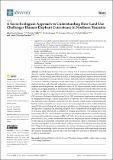| dc.description.abstract | A globally rapid land use/land cover change (LULC) in human-transformed landscapes alters the interface of human-wildlife interactions due to shifting socio-ecological and environmental pressures. Understanding these shifts is crucial for mitigating repeated negative interactions that escalate conflict states between people and wildlife. This study aimed to understand LULC changes over 30 years (1989–2019), with more recent spatio-temporal patterns of high pressure at the human-elephant interface, and potentially underlying environmental and human-driven factors that affect elephant movement patterns. We analyzed a dataset of 923 human-elephant conflict occurrences, mainly crop foraging incidents, in the Enduimet Wildlife Management Area (EWMA) between the years 2016 and 2020 and combined these data with LULC for year 2019 to understand potential drivers of conflict and assess how agricultural land and settlement have increased over time. We further used GPS datasets of elephants collared between 2019 to 2020 to understand elephant movement patterns in changing land use types. Landsat image analysis revealed that 41% of the area had been converted into farmlands and settlements within the last three decades, which creates elephant-intolerant habitats and the potential to increase pressure at the human-elephant interface. Collared elephants using EWMA moved through all land use types and did not avoid settlements, although they moved through these at higher speeds, reflecting perception of risk. Elephants travelled slightly more slowly in farmland, likely reflecting the availability of foraging opportunities. Our analysis shows that human-induced LULC changes and the encroachment into elephant habitats have resulted in spatially and temporally predictable increases in HEC in EWMA, driven by the proximity of farmlands and protected areas (PAs), so that incompatible land uses are the principal drivers of damage to human livelihoods and increased risks to Tanzanian (and Kenyan) natural capital. Communities in Enduimet urgently need support to increase the effective distance between their farming activities and the PAs. Village-level crop protection and small-scale land-use planning around PAs are important first steps to halt an escalating conflict situation but need to be supported with longer-range strategies that separate incompatible land-use types and encourage the cultivation of alternative crops and livelihood diversification. | en_US |

